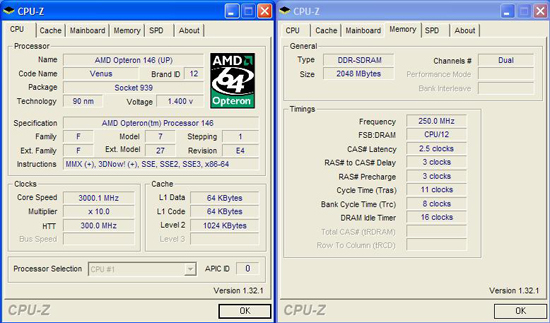ABIT AN8 32X SLI Motherboard Review
The Tests: Overclocking
*In our overclocking, we considered the board to be stable if we were able to run our battery of tests and if we were able to run the SuperPi 32MB test completely through.
We started out with high hopes in our overclocking adventures with this board. Using the AMD Opteron 146 processor that we did our benchmark testing with, we knew that we could potentially reach some very good numbers, as this processor (and many other Opterons like it) is able to do 3.0GHZ with ease. With a default mutiplier of 10x, this means we can do an HTT of 300, as long as the board allows it. So, we set off to see if we could reach any new heights with our CPU. We immediately started out at 300×10, leaving the vcore at 1.4v. As expected, the board would not boot. It took 1.48v on both the DFI Expert and SLI-D to get to 3.0GHZ, so we set the vcore to 1.5v and rebooted. Once again… we got nothing. The board did not even try to boot. We spent many hours trying to diagnose the problem, trying different memory timings and dividers, trying different CPU multipliers and vcore settings. Nothing seemed to work at all. At this point, we actually thought that maybe what was holding us back was the lack of chipset voltage adjustment, as we were only able to get the board to do 279HTT. Nothing more at all. In fact, the board did not even try to boot at 280 or above. After several conversations with ABIT explaining the situation, we were sent a beta bios to test with the board, and the 279 limitation was gone! Bravo ABIT for listening and producing a new bios to correct issues in a timely manner! At this point, we are not sure if it was an Opteron issue or an issue with any CPU, but whatever it was, it is fixed!
So, what did the new bios do for us? It allowed us to get into some real overclocking! With the new bios in place, we were able to easily run at an HTT of 300 with our Opteron at its default multiplier of 10x. Lowering the multiplier to 9x, we continued on and were able to reach an astounding HTT of 325. We lowered the multiplier again, but no matter how low we went, it seems as if 325 was our limit. Can the board do more? Possibly. If ABIT would put into a new bios the ability to raise the chipset voltage, we might be able to squeeze just a little more out of this board. So, our final and best at overclocking this board as it stands right now is represented in the following picture:


Comments are closed.